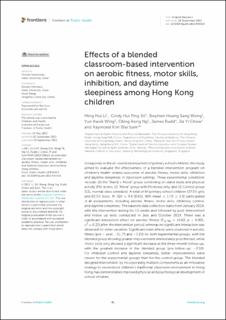| dc.contributor.author | Li, Ming Hui | |
| dc.contributor.author | Sit, Cindy Hui Ping | |
| dc.contributor.author | Wong, Stephen Heung Sang | |
| dc.contributor.author | Wing, Yun Kwok | |
| dc.contributor.author | Ng, Ching Kong | |
| dc.contributor.author | Rudd, James Robert | |
| dc.contributor.author | Chow, Jia Yi | |
| dc.contributor.author | Sum, Raymond Kim Wai | |
| dc.date.accessioned | 2022-12-01T10:02:17Z | |
| dc.date.available | 2022-12-01T10:02:17Z | |
| dc.date.created | 2022-10-19T08:55:18Z | |
| dc.date.issued | 2022 | |
| dc.identifier.citation | Frontiers in Public Health. 2022, 10, Artikkel 944423. | en_US |
| dc.identifier.issn | 2296-2565 | |
| dc.identifier.uri | https://hdl.handle.net/11250/3035255 | |
| dc.description | This is an open-access article distributed under the terms of the Creative Commons Attribution License (CC BY). The use, distribution or reproduction in other forums is permitted, provided the original author(s) and the copyright owner(s) are credited and that the original publication in this journal is cited, in accordance with accepted academic practice. No use, distribution or reproduction is permitted which does not comply with these terms. | en_US |
| dc.description.abstract | In response to the all-round development of primary school children, this study aimed to evaluate the effectiveness of a blended intervention program on children's health-related outcomes of aerobic fitness, motor skills, inhibition and daytime sleepiness in classroom settings. Three experimental conditions include: (1) the “Stand + Move” group combining sit-stand desks and physical activity (PA) recess, (2) “Move” group with PA recess only, and (3) Control group (CG; normal class schedule). A total of 64 primary school children (37.5% girls and 62.5% boys, M [SD] = 9.6 [0.61], BMI mean = 17.0 ± 3.0) participated in all assessments, including aerobic fitness, motor skills, inhibitory control, and daytime sleepiness. The baseline data collection starts from January 2019, with the intervention lasting for 13 weeks and followed by post-intervention and follow up tests conducted in July and October 2019. There was a significant interaction effect on aerobic fitness [F(2,76) = 10.62, p < 0.001, η2 = 0.22] after the intervention period, whereas no significant interaction was observed for other variables. Significant main effects were observed in aerobic fitness (pre – post: −11.75 and −7.22) for both experimental groups, with the blended group showing greater improvements immediately post the test, while motor skills only showed a significant increase at the three-month follow-up, with the greatest increase in the blended group (pre-follow-up: −2.50). For inhibition control and daytime sleepiness, better improvements were shown for the experimental groups than for the control group. The blended designed intervention, by incorporating multiple components as an innovative strategy to reconstruct children's traditional classroom environment in Hong Kong, has demonstrated improved physical and psychological development of school children. | en_US |
| dc.language.iso | eng | en_US |
| dc.subject | children | en_US |
| dc.subject | inhibition | en_US |
| dc.subject | motor skill | en_US |
| dc.subject | physical literacy | en_US |
| dc.subject | primary school | en_US |
| dc.subject | sit-stand desk | en_US |
| dc.subject | sleep | en_US |
| dc.title | Effects of a blended classroom-based intervention on aerobic fitness, motor skills, inhibition, and daytime sleepiness among Hong Kong children | en_US |
| dc.type | Peer reviewed | en_US |
| dc.type | Journal article | en_US |
| dc.description.version | publishedVersion | en_US |
| dc.rights.holder | © 2022 Li, Sit, Wong, Wing, Ng, Rudd, Chow and Sum | en_US |
| dc.source.pagenumber | 12 | en_US |
| dc.source.volume | 10 | en_US |
| dc.source.journal | Frontiers in Public Health | en_US |
| dc.identifier.doi | 10.3389/fpubh.2022.944423 | |
| dc.identifier.cristin | 2062583 | |
| dc.description.localcode | Institutt for lærerutdanning og friluftslivsstudier / Department of Teacher Education and Outdoor Studies | en_US |
| dc.source.articlenumber | 944423 | en_US |
| cristin.ispublished | true | |
| cristin.fulltext | original | |
| cristin.qualitycode | 1 | |
